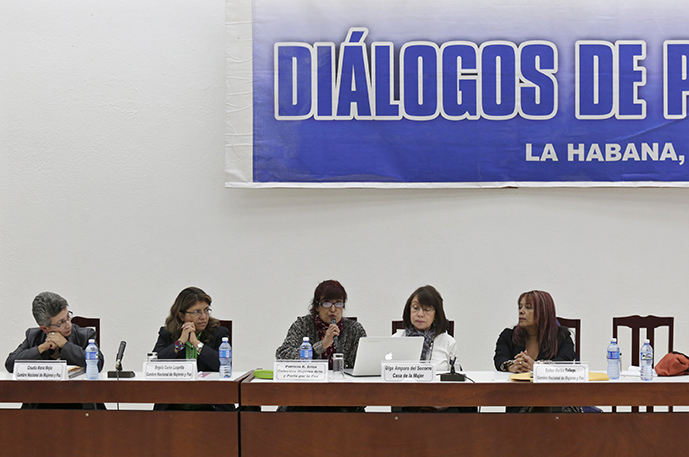 A pledge by Colombian President Juan Manuel Santos and Rodrigo Londoño (better known by the nom de guerre Timochenko), the leader of the Revolutionary Armed Forces of Colombia-People’s Army (FARC-EP), at their historic meeting in Havana on September 23 to end Latin America’s longest-running conflict within six months has raised expectations for peace. But while this breakthrough provides a glimmer of hope, the biggest challenge—that of peace building—lies ahead.
A pledge by Colombian President Juan Manuel Santos and Rodrigo Londoño (better known by the nom de guerre Timochenko), the leader of the Revolutionary Armed Forces of Colombia-People’s Army (FARC-EP), at their historic meeting in Havana on September 23 to end Latin America’s longest-running conflict within six months has raised expectations for peace. But while this breakthrough provides a glimmer of hope, the biggest challenge—that of peace building—lies ahead.
The assassination of Jorge Eliécer Gaitán, a political leader who was considered the champion of the people, in the streets of Bogotá on April 9, 1948, was the spark that set off the long-running war in Colombia. By the 1960s, left-wing guerilla groups started to join hands in their fight against the government. FARC-EP was the largest of these groups.
Despite several attempts to achieve peace, the Colombian government has failed to end the war via a negotiated settlement.
The Peace Process
After three years of intense discussions, negotiations with the FARC-EP produced a preliminary agreement on agrarian reform, political participation, drugs, and a truth commission. However, transitional justice, one of the most complicated elements of a peace agreement, had yet to be agreed on and risked failure in the midst of an escalation of the conflict this past summer.
“Transitional justice commonly resorts to four measures: criminal prosecutions, truth commissions, reparation programs, and institutional reforms,” James Stewart, Deputy Prosecutor of the International Criminal Court (ICC), said in a May 13 speech in Colombia.
The announcement following the September 23 meeting between Santos and Timochenko in Havana is remarkable in the sense that it includes these four measures, and is also noteworthy for these reasons:
- The agreement places the needs and the reparations of the victims at center-stage. It is one of the world’s most creative and comprehensive agreements in conflict resolution. The negotiating parties clearly studied and absorbed lessons learned in El Salvador, Guatemala, and South Africa, amongst others.
- The parties are focusing on restorative justice rather than punitive justice. This being said, punitive justice will be applied to people who do not recognize their crimes and are not willing to contribute to truth telling. The government is thus willing to give perpetrators a chance to reintegrate into society. Without an exhaustive process of reintegration, it will be impossible to reconstruct the moral and social fibers of Colombian society.
- Disarmament—within sixty days of signing the final agreement—is a pre-condition for participation in the transitional justice framework.
- Judges will be both national and international experts.
- The agreement initially seems to abide by international treaties such as the Geneva Conventions of 1949, their Additional Protocols, and Statutes. This would mean that there are tools to prevent the most serious crimes—genocide, crimes against humanity and war crimes—from going unpunished.
The White House said it was “encouraged” by the developments in Havana. Such support will give Santos additional confidence and leverage to face down his political opponents.
The road ahead
As Santos and the FARC now work to transform the glimmer of hope for peace into reality, here are some things to keep in mind:
- The timeline for achieving peace is not as important as the announcement on the transitional justice issues. Deadlines can be risky in conflict resolution. Rushing the process could produce negative long-term consequences.
- Colombia is a State Party to the Rome Statute of the International Criminal Court, which “may exercise its functions and powers, as provided in this Statute, on the territory of any State Party.” This complementarity is not only pressure on the government to “do it right,” but also an assurance to the people of Colombia that there will be no impunity.
- Terms for disarmament are yet to be determined, but will certainly be verified by international organizations.
- Extradition is still on the table. The United States will play a lead role in shaping this issue.
- The Colombian people still need to endorse the final agreement. International actors such as UNASUR and the United Nations, which have been present at the negotiating table in Havana since July, will verify the implementation.
- Even if a peace agreement is eventually signed, Colombia will face the most difficult challenge yet: peace building. The country needs to be prepared for this historic moment. In every post-conflict situation, but particularly in Colombia, general agreements should be attuned to local and regional necessities, especially as it relates to the needs of the victims.
Andrea Saldarriaga Jiménez is a Project Assistant in the Atlantic Council’s Adrienne Arsht Latin America Center.
Image: Cuban President Raúl Castro (center) joins Colombian President Juan Manuel Santos (left) and FARC rebel leader Rodrigo Londoño, better known by the nom de guerre Timochenko, as they shake hands in Havana on September 23. Santos and the top commander of leftist FARC rebels agreed to reach a final peace agreement in Latin America's longest war within six months. (Reuters/Alexandre Meneghini)
